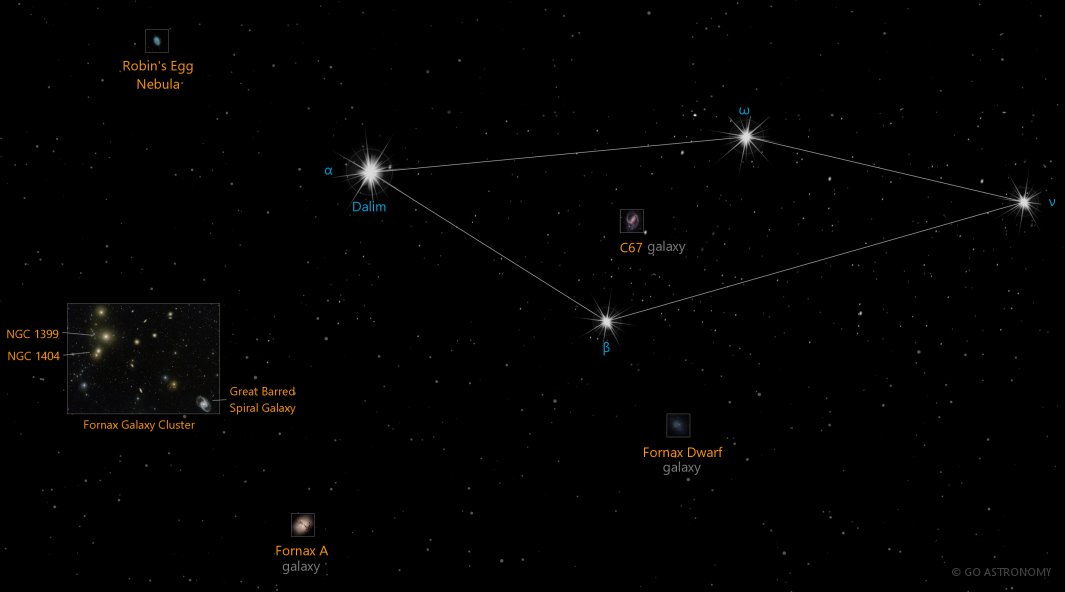Fornax, the Furnace (For)
(FOR-naks)
The Southern constellation of Fornax, the Furnace, is best viewed in Winter during the month of December.
Fornax is the 41st largest constellation. It's brightest star is Alpha Fornacis at magnitude 3.80. The boundary of the Fornax constellation contains 6 stars that host known exoplanets.
- Pronunciation:
- FOR-naks
- Meaning:
- Furnace
- Genitive:
- Fornacis
- Abbreviation:
- For
- Constellation Family:
- LaCaille
- Hemisphere:
- Southern
- Quadrant:
- SQ1
- Visibility:
- 50° N - 90° S
- Best viewing month*:
- December
- Area:
- 398 sq. degrees
- Size:
- 41st largest
- Right Ascension (avg):
- 2h 46m
- Declination (avg):
- -31°
- Brightest star:
- Alpha Fornacis (3.80)
- Stars with planets:
- 6
- Messier objects:
- |
Brightest Stars in Fornax
The 10 brightest stars in the constellation Fornax by magnitude.
- Star
- Magnitude
- Spectral class
- Alpha Fornacis (α For)
- 3.85
- F8V
- Beta Fornacis (β For)
- 4.45
- G8III
- Nu Fornacis (ν For)
- 4.68
- B9.5p (Si)
- Omega Fornacis (ω For)
- 4.96
- B9V
- Delta Fornacis (δ For)
- 4.99
- B5III
- Phi Fornacis (φ For)
- 5.13
- A2/A3V
- Kappa Fornacis (κ For)
- 5.19
- G2V
- Mu Fornacis (μ For)
- 5.27
- A0V
- Pi Fornacis (π For)
- 5.34
- G8III
- Gamma Fornacis (γ2 For)
- 5.39
- A1V
Nebulae in Fornax
Notable and easy-to-find nebulae in the constellation Fornax . Also see all nebulae.
Galaxies in Fornax
The most notable galaxies in the constellation Fornax. Also see all galaxies.
- Name
- Alt name
- Type
- Fornax A
- lenticular
- Fornax Dwarf
- elliptical dwarf
- Arp 77
- C67
- galaxy pair
- Fornax B
- spiral
- Great Barred Spiral Galaxy
- spiral
Milky Way Satellites in Fornax
Dwarf satellite galaxies that orbit the Milky Way Galaxy located in the constellation Fornax. Also see all Milky Way satellite galaxies.
- Galaxy name
- Alt name
- Magnitude
- Fornax Dwarf
- 9.3
The Celestial Furnace
Fornax, the Furnace, is a constellation situated in the southern hemisphere's celestial sphere. It was introduced by the French astronomer Nicolas Louis de Lacaille in the mid-eighteenth century, named after a type of chemical oven used for experiments. While not particularly conspicuous or large, Fornax contains a host of deep-sky objects and has been the site of many fascinating astronomical discoveries.
Historical Overview
Fornax is one of the 14 constellations introduced by Nicolas Louis de Lacaille during his expedition to the Cape of Good Hope between 1751 and 1753. Originally named "Fornax Chemica," the Chemical Furnace, it was later shortened to simply Fornax. It symbolizes the furnace used by scientists during Lacaille's time for chemical experiments and transformations. The constellation is now officially recognized as one of the 88 modern constellations by the International Astronomical Union (IAU).
Location and Main Features
Fornax is located in the first quadrant of the southern hemisphere (SQ1) and is visible at latitudes between +50? and -90?. It is bordered by the constellations Cetus, Eridanus, Phoenix, Sculptor, and Pisces Austrinus. Fornax spans over an area of approximately 398 square degrees, making it the 41st largest constellation in the sky.
Major Stars
The brightest star in Fornax is Alpha Fornacis, a spectral class G8III yellow giant star located approximately 46 light-years away from us. Its apparent magnitude is 3.85, and it's roughly 34 times more luminous than our Sun.
Beta Fornacis, the second brightest star, is a spectral class F5III yellow-white giant star with an apparent magnitude of 4.47, situated around 169 light-years away from our solar system. Other prominent stars in Fornax include Nu, Kappa, and Epsilon Fornacis.
Deep Sky Objects
Fornax is home to a significant number of galaxies as it houses the Fornax Cluster, one of the closest galaxy clusters to the Milky Way. It's about 62 million light-years away and contains nearly 60 galaxies, including the barred spiral galaxy NGC 1365 and the lenticular galaxy NGC 1316, also known as Fornax A.
NGC 1365 is sometimes referred to as the Great Barred Spiral Galaxy and is one of the most prominent barred spirals visible in the sky. Fornax A, NGC 1316, is the fourth brightest radio source in the sky and is known for its intricate system of dark dust lanes.
Observation
Fornax, being a southern constellation, is best observed from the southern hemisphere during the months of November through January. Though it doesn't contain any exceptionally bright stars, its wealth of galaxies makes it a favorite target for deep-sky observers and astrophotographers. Binoculars or small to medium-sized telescopes will provide the best view of these distant objects.
Fornax in Modern Astronomy
In recent years, Fornax has been the focus of significant astronomical research due to the Fornax Cluster and the Fornax Dwarf, a dwarf galaxy that's a satellite of our Milky Way. The Fornax Cluster offers scientists insights into galaxy formation and evolution, while the Fornax Dwarf is used to study the history of star formation.
* Constellation shown for northen hemisphere skies. For the southern hemisphere, constellations appear rotated 180 degrees (upside-down and left-right reversed) from what is shown. Remember that seasons are reversed too - summer in northern latitudes is winter in southern latitudes.
** Circumpolar constellations are visible year-round in the hemisphere listed (and not at all in the opposite hemisphere).





